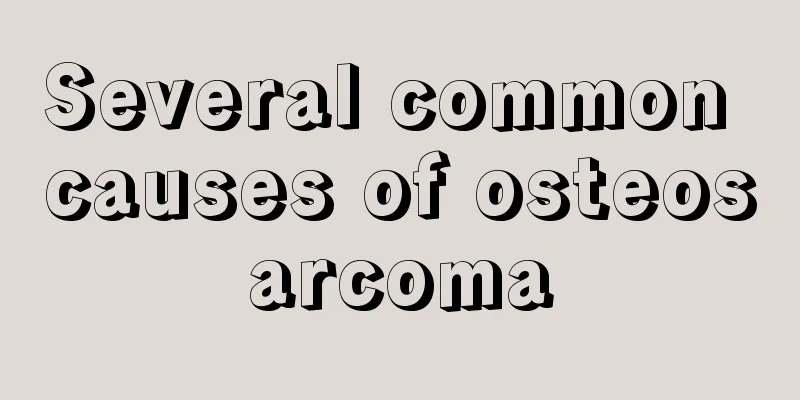Several common causes of osteosarcoma

|
Osteosarcoma causes patients to suffer physically and mentally. Patients' families bear huge treatment costs, which directly affects the quality of life of the whole family and causes great disasters to the family. The treatment process includes chemotherapy, surgical resection or amputation. Let's take a closer look at several common causes of osteosarcoma: 1 Clinically, it is not very clear what causes osteosarcoma. Some patients develop symptoms of osteosarcoma, and the main inducing factors are trauma and stimulation, as well as viral infection, all of which will directly lead to osteosarcoma. 2 The occurrence of osteosarcoma also includes some genetic factors, as well as the patient's exposure to some radioactive substances, or viral infection, etc. When osteosarcoma occurs, patients are often prone to secondary symptoms, because this is caused by the malignant transformation of benign tumors. Primary osteosarcoma is related to genetics: ① The risk of osteosarcoma in patients with retinoblastoma is about 2000 times higher than that of the normal population. This is because the retinoblastoma gene (Rb gene) is a tumor suppressor gene located on the long arm of chromosome 13 (13q14). The deletion or inactivation of this gene is the direct cause of retinoblastoma. In cases of sporadic or associated osteosarcoma with retinoblastoma, there is often a deletion of the Rb gene. In cases of bilateral retinoblastoma, about 12% develop osteosarcoma, and more than 70% of osteosarcoma cases have inactivated Rb gene products. ② In many sporadic cases, there is often a mutation in another tumor suppressor gene p53, which is located on the short arm of chromosome 17. The incidence of osteosarcoma is significantly increased in families with Li-Fraumeni syndrome who have p53 gene mutations. 45% of osteosarcomas have p53 gene mutations. 3 The pathogenesis of osteosarcoma is not very clear now, but the symptoms of osteosarcoma are mainly a kind of primitive group of cells. In clinical practice, patients can further diagnose the disease through some examination methods. Once diagnosed, we must seize the time to treat it. Osteosarcoma, like other human tumors, has unclear etiology and mechanism. Its pathogenic factors are very complex. The internal factors include the diathesis theory, the genetic theory, the endocrine theory, etc.; the external factors include chemical substances, internal and external radiation, the chronic inflammatory stimulation theory, the viral infection theory, etc. Some other benign bone tumors such as Paget's disease, giant cell tumor of bone, and dysplastic bone fibrous tissue structure can cause osteosarcoma, which is more common in patients after middle age. Note: The above mentioned are the causes of osteosarcoma. It is recommended that everyone must prevent the occurrence of osteosarcoma as early as possible in life. At the same time, patients should not worry too much and should maintain an optimistic attitude to actively treat the disease. |
<<: Detailed overview of osteosarcoma
>>: What is the cause of osteosarcoma
Recommend
How much does an endometrial cancer checkup cost?
The key to treatment is early stage. Some patient...
Is malignant melanoma as harmless as a mole?
People often mistake malignant melanoma for moles...
My husband has a bad temper and is easily angry and hits people
For women, they must clearly understand their par...
What should lung cancer patients eat? Introduction to the diet of lung cancer patients
Due to some unhealthy eating and living habits, m...
Is pituitary tumor serious? Is pituitary tumor a benign tumor?
Pituitary tumors are benign tumors. Active treatm...
What is ethmoid sinus osteoma
Tumors are a common phenomenon that occurs in peo...
Sharp and wet scrotum
Many men will feel scrotal pain. A careful observ...
Is kidney cancer contagious?
Once kidney cancer occurs, it is very difficult t...
Which hospital is good for endometrial cancer
Which hospital is good for treating endometrial c...
Why does smoking cause laryngeal cancer again and again
As the most common cause of laryngeal cancer, smo...
Is a malignant pulmonary nodule lung cancer? Is it early stage lung cancer
Malignant lung nodules are actually early-stage l...
What to do if there is always soft plaque on teeth
Many people have a layer of soft or hard substanc...
What to eat to prevent lymphoma
We know that people nowadays are under great pres...
Will gallbladder cancer be passed on to children?
Some patients with gallbladder cancer and their f...
Cleft palate repair
We often see many babies with cleft lip and palat...









